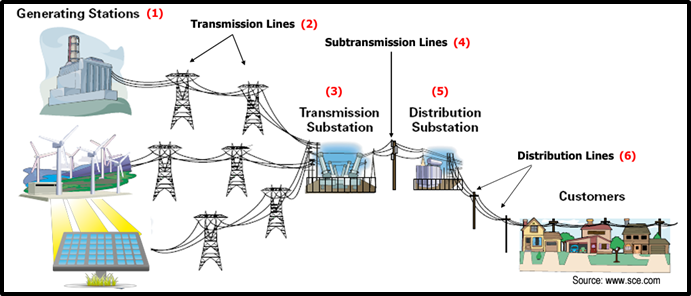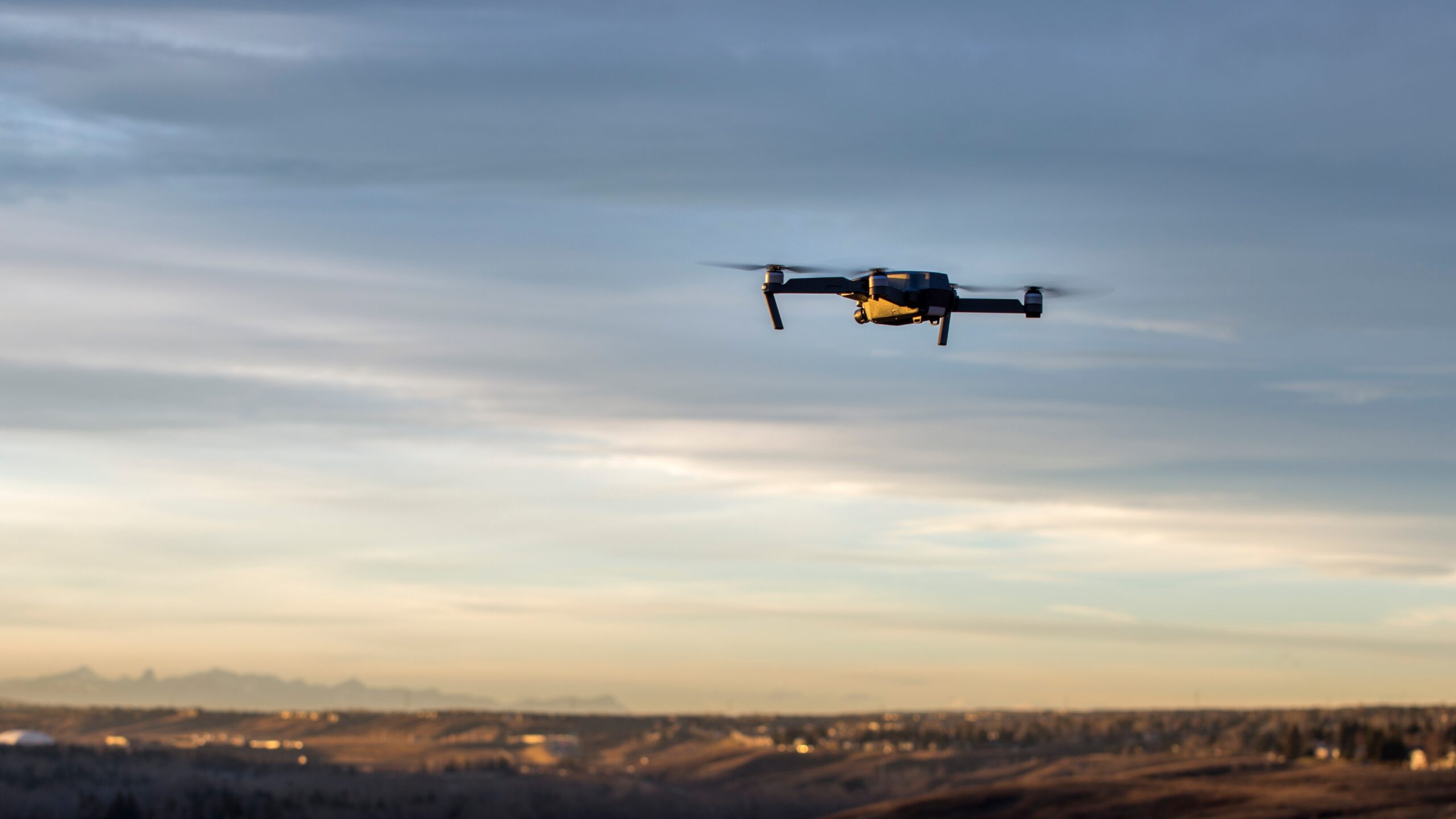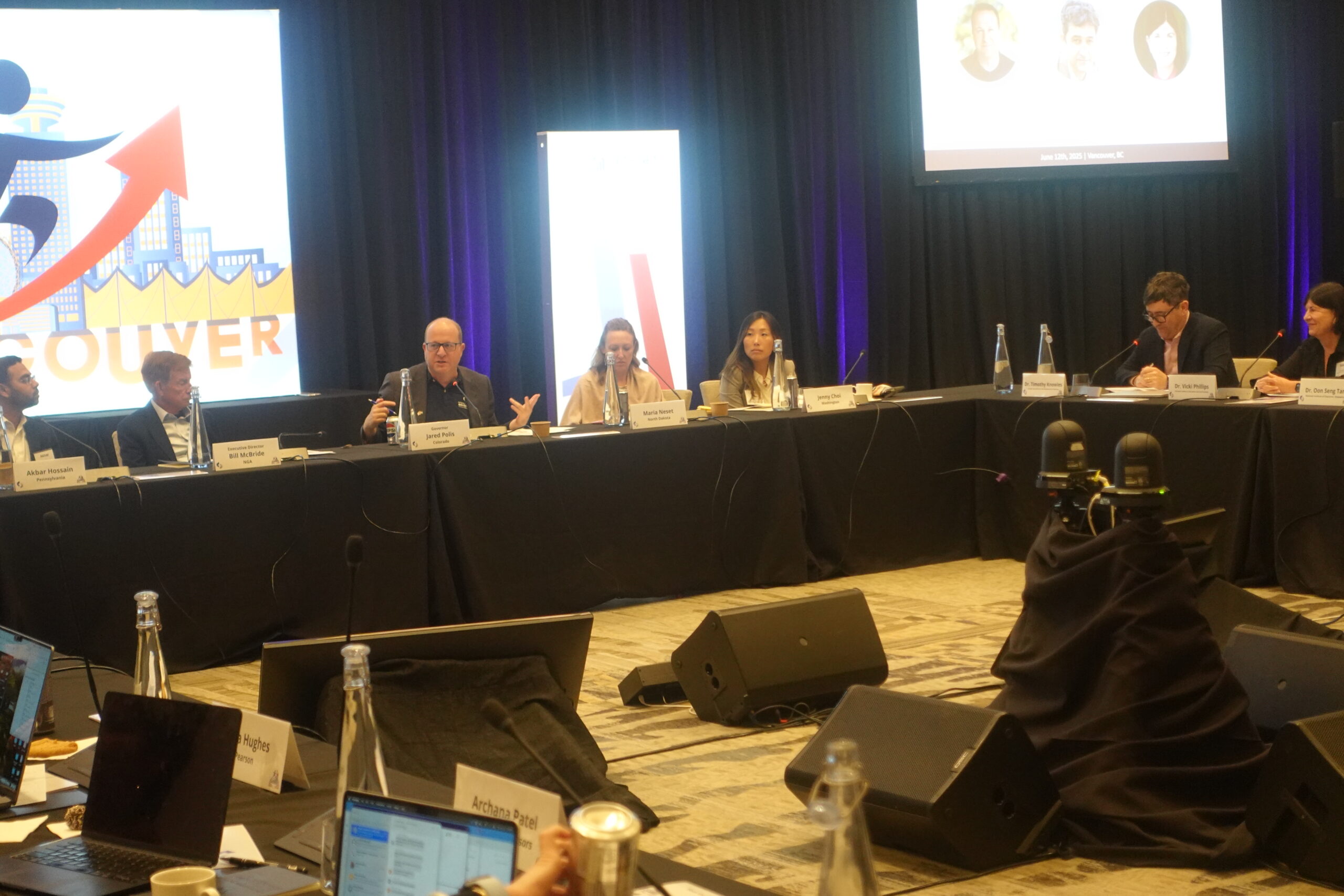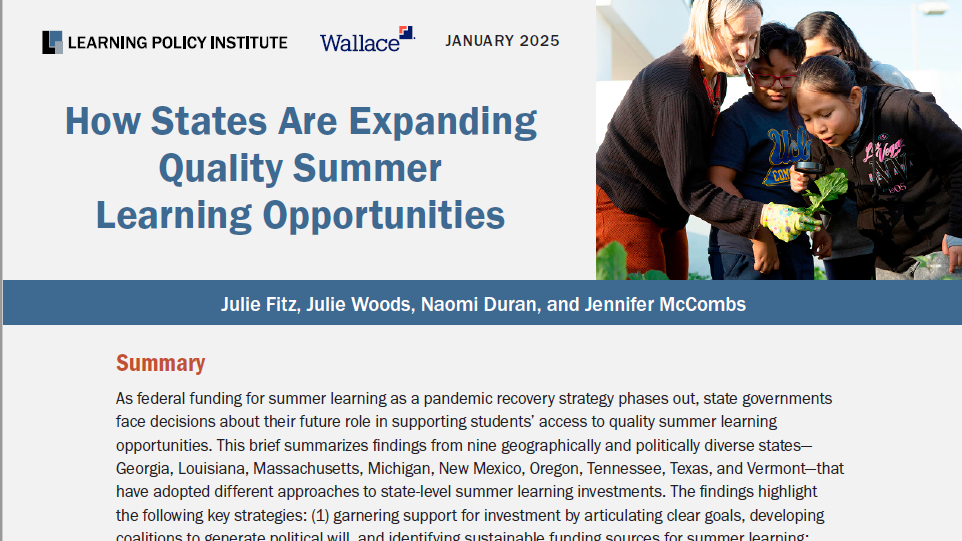Electric transmission expansion can be important for Governors to realize their policy objectives. However, multiple siting, permitting, and regulatory challenges pose significant barriers to transmission expansion. NGA is publishing this background brief to provide important background for Governors and Governors’ staff and highlight the tools Governors have at their disposal, based on state best practices, to more smoothly navigate and advance transmission projects.
(Download)
Introduction
The United States electrical grid is often referred to as the “largest machine ever made.” This “machine” was built across the United States over the course of the 20th century. The electrical grid crosses every county or parish of every state and territory of the United States. While the notion of the electrical grid as a single “machine” that provides power to every American is compelling, in reality the grid is comprised of thousands of entities operating fractions of the grid simultaneously. Given the mosaic nature of operation and governance of the electric grid, it has operated remarkably well for decades.
However, challenges to the grid, as it is currently structured, are beginning to mount. Extreme weather events, increasing demand for electricity, expanding technologies such as electric vehicles, and even individual policy decisions present new and evolving challenges to reliable grid operation. These challenges can be exacerbated by a geographic or temporal misalignment of power supply and demand. Electricity is needed in every home and business across the country but has historically only been produced in a relatively small number of places, e.g., powerplants. This has necessitated robust investment in transmission, high voltage long distance infrastructure, and distribution, lower voltage local infrastructure, across the grid. With the widespread deployment of renewable energy technologies such as wind and solar, we are encountering this fundamental misalignment at an even greater scale. The variable nature of these technologies requires further time-based balancing through storage or other means to make energy available when it is needed. There is growing recognition among policymakers and energy industry officials that expanding transmission infrastructure is key to meeting the challenges facing the grid and key to capitalizing on the opportunities offered by renewable energy.
The Edison Electric Institute estimated that their members, investor-owned utilities, invested $25 billion in transmission infrastructure in 2020 and another $27.8 billion in 2021. While these sums are substantial, they may not be sufficient. Even with these funds invested in transmission development, the possibility of lengthy project delays or failure remain. High profile public disputes over transmission projects in New Hampshire and Maine illustrate the complexity and potential risk of transmission development. A study by Princeton University estimated the United States would need to expand capacity 60% by 2030 to be on track to achieve a zero-carbon future by 2050. This would amount to an investment of roughly $360 billion by 2030 and $2.4 trillion by 2050. Timing is also a critical factor. A recent joint report on offshore wind transmission development, led by Brattle Group, found that beginning proactive planning for offshore projects immediately could save U.S. consumers at least $20 billion and reduce environmental and community impacts by 50%.
In response to these important challenges, Governors are taking a more active role in planning, maintaining, and appropriately siting transmission lines. There are various coordination, information sharing, and policy challenges that limit transmission expansion. To discuss these concerns, the National Governors Association Center for Best Practices (NGA Center) is publishing this background brief to support Governors and Governors’ staff on what actions and tools Governors have at their disposal, based on state best practices, to more smoothly navigate the siting and permitting process for transmission projects.
challenges to building transmission infrastructure
A variety of intersecting issues and concerns make transmission siting and permitting in general, and interstate/regional transmission siting and permitting in particular, difficult and time consuming to effectuate.
Challenge #1: The Fragmented Nature of Grid Planning and Operation
Since multiple entities plan, build, and operate the electrical grid, long distance planning, resource allocation, and cost-sharing questions bog down the siting and planning process.
Solutions for Governors:
- Governors can convene stakeholders from the public and private sectors to identify areas of agreement to build consensus.
- Governors can pursue regional compacts and multistate agreements to establish direct, state-to-state planning procedures, negotiate cost-sharing, and build capacity to streamline complex interstate project planning.
- Governors can create state siting offices to coordinate intrastate and interstate transmission siting and permitting efforts.
- Governors can shape state regulatory and policy processes through strategic appointments to public utility commissions, state energy offices, and other relevant state agencies.
Challenge #2: Transmission Line Right of Way Route Planning
Transmission lines are large and highly visible pieces of infrastructure with wide rights of way – in some instances up to 200-500 feet from the asset. The height of transmission towers can also impact historic, cultural, or natural landscapes.
Solutions for Governors:
- Governors can employ strategic land-use to steer transmission routes to publicly owned property and/or away from environmentally or culturally sensitive areas.
- Governors can co-locate transmission infrastructure along existing or previously impacted areas such as highway corridors or existing infrastructure rights of way.
- Governors can form strong partnerships with federal land managing partners and Tribal Nations to build consensus around proposed routes early in the siting and planning process.
Challenge #3: Community Opposition to Transmission Routes
Route selection can become controversial due to real or perceived impacts on the environment, home values, natural resources, cultural resources, and current land ownership.
Solutions for Governors:
- Governors can take an active role in advocating for specific transmission projects by working with transmission developers to directly communicate the benefits to their constituents.
- More broadly, Governors can directly engage local communities to communicate transmission benefits and ensure that local concerns are brought to the negotiating table.
Challenge #4: Bringing Offshore Wind Transmission On-Shore
Not all challenges are negative. Offshore wind development offers an enormous and largely untapped supply of carbon free energy. However, the specific ownership and organizational practices of offshore transmission line development are still being negotiated. Furthermore, there are limited points where offshore wind transmission lines can connect to onshore infrastructure.
Solutions for Governors:
- Governors could opt for a single state/territory approach to plan offshore wind transmission.
- Conversely, Governors can act jointly with other states in their region to proactively plan and develop offshore wind transmission.
- Governors can apply many of the solutions previously discussed under challenges #1-3 to challenges specifically related to offshore wind.
This brief is divided into five sections. The first portion of the brief is the Background Section, which briefly describes the technical background of the United States electrical grid. The Background Section also briefly discusses the regulatory entities that interact with transmission projects at the federal, regional, state, and local levels, describing the relevant parties and their authorities. The next section discusses the complexity of siting and planning transmission projects and discusses permits that might be required for such projects. Section Three describes the roles and responsibilities of Governors regarding siting and permitting transmission projects. Section Four offers a variety of tools and options that Governors may choose to employ to mitigate risk of failure on complex transmission projects and ultimately speed up the process. Finally, the fifth section concludes the brief by situating transmission projects within larger economic and policy developments that affect states and territories.
Section 1 | Background: Technical Context and Regulatory Entities
Technical
A transmission line’s primary function is to transport high voltage electricity over a long distance, connecting energy producers to energy consumers. Transmission lines can be classified into three general categories: high voltage overhead transmission, high voltage underground transmission, and sub-transmission lines. High voltage overhead transmission lines traverse most of the distance between the energy producer and the consumer. Overhead transmission lines are the most common type of transmission line. High voltage underground transmission lines have historically been the more expensive option compared to the overhead alternative, but they can be cost effective when it is difficult to build above ground, such as when crossing large bodies of water or large metropolitan areas, or when they bring substantial resilience benefits. Underground transmission is considered an option to improve system resilience where natural hazards like high winds may threaten above-ground infrastructure. Sub-transmission lines branch off the high voltage transmission lines and are “stepped down” at substations to a lower voltage connecting to local distribution lines. When discussing transmission lines, most are referring to high voltage overhead transmission.
Transmission lines can also be classified as interstate or intrastate. Depending on the distance electricity travels and the differing technical needs of the grid, electricity can be transmitted along transmission lines in either alternating current (AC) or direct current (DC).
- Interstate transmission lines cross jurisdictional boundaries into other states or territories. Interstate transmission lines are primarily sited, permitted, and constructed at the state level, with each affected state providing approval of interstate projects. Although the Federal Energy Regulatory Commission (FERC) does not directly regulate interstate transmission lines, it may provide financial incentives to energy companies to propose and build transmission lines.
- Intrastate transmission lines are built wholly within a single state or territory.10F10F[vii] Intrastate transmission lines are generally regulated by state Public Utility Commissions (PUCs) and other state and local government entities.
- Alternating Current (AC) shifts direction periodically. A “cycle” is one full period, in which current flows one direction and then in the other direction. Sixty cycles per second is considered the standard frequency in North America. The bulk of transmission lines support AC power. Transformers are used to ramp the voltage of AC energy up and down for easier transmission.
- Direct Current (DC) flows unidirectionally and is very useful to transmit electricity over long distances and between grids that use different frequencies of energy. The ability to connect asynchronous grids across vast distances is crucial to providing regional and interregional resilience and distributing the benefits of renewable energy. Unlike AC, DC energy cannot easily change its voltage via transformers. As such, DC energy must be converted back to AC energy to be used within a local system. The United States electric grid predominately uses AC energy, but high voltage direct current (HVDC) is increasingly important for transporting energy long distances with less electricity loss and often at a lower cost.
Ratemaking Process
Transmission infrastructure is extremely capital intensive to build. Though not directly a siting and permitting issue, disputes over ratemaking can act as an impediment to transmission development. Regulated rates are very complex. For the purposes of this brief, the most pertinent component on ratemaking is the return on investment through rate of return on invested capital. For intrastate transmission lines, the state public utility commission (PUC) will conduct rate proceedings and award a reasonable rate of return on prudently invested capital to the utility that constructs the transmission lines. In addition, the Federal Energy Regulatory Commission (FERC) has oversight of ratemaking in most transmission projects. FERC approves the rules that determine how the cost for such projects should be allocated. Since a long-distance transmission line may cross multiple states, the analysis of who benefits and who should pay for such infrastructure is anything but straightforward. The PUC of each state will work to make sure that their ratepayers are not unduly subsidizing projects whose benefits may accrue elsewhere.
Regulatory Authorities: Transmission Siting & Permitting
For the purposes of this document, the regulations that will be discussed will focus on the siting and permitting processes. Transmission siting refers to determining the exact route the transmission line will take. Transmission permitting refers to the permits and approval required for building a transmission line, such as Environmental Impact Analysis and other local, state or federal authorizations. Transmission siting and permitting are often discussed in tandem during the planning process for a transmission project. The transmission siting and permitting process is one of the most difficult parts of the planning process because of the time-consuming nature and complex, federal, state, territorial and local regulatory structures that must be navigated. Doing so can take a decade or longer.
Regulatory Authorities: Federal
There are several federal agencies that have a role in interstate transmission projects. The primary regulator is the Federal Energy Regulatory Commission (FERC). FERC approves wholesale interstate electric transmission sales and tariffs. The United States Department of Energy (DOE) has jurisdiction over the coordination of federal authorizations that pertain to interstate transmission projects that are located in national interest electric transmission corridors. The Infrastructure Investment and Jobs Act (IIJA) has given FERC some limited backstop siting authority within transmission lines that DOE has determined are in the national interest. FERC has not yet finalized the rules governing this backstop authority. Additionally (DOE) has some jurisdiction to engage with the design, research, and development of new and select existing transmission facilities.
Other federal agencies that may have jurisdiction over permitting transmission projects include the Department of Interior’s Bureau of Land Management (BLM), the Fish and Wildlife Service (FWS), the National Park Service (NPS), the Department of Agriculture’s Forest Service (USFS), the Department of Defense’s Army Corps of Engineers (USACE), and the Environmental Protection Agency (EPA). While many of the above agencies do not have direct oversight of transmission projects, as land managing agencies, they administer a large amount of the U.S. landmass. Interacting with federal lands often requires additional permitting and planning requirements.
- Federal Energy Regulatory Commission (FERC)
- FERC is the principal regulator of the transmission and sale of wholesale electricity, but the approval to construct electric transmission lines is usually approved by the individual states.
- FERC also engages with stakeholders in many non-regulatory ways.
- FERC has partnered with the National Association of Regulatory Utility Commissioners (NARUC) to create the Joint Federal-State Task Force on Electric Transmission.
- The task force focuses on topics related to planning and paying for transmission, including transmission to facilitate generator interconnection, that provides benefits from both a federal and state perspective.
- United States Department of Energy (DOE)
- DOE is tasked with ensuring the security and prosperity of the United States by addressing its energy, environmental and nuclear challenges through transformative science and technology solutions.
- DOE does not directly regulate transmission but is involved in nationwide transmission planning and efforts to improve siting and permitting at the state and federal level through its Grid Deployment Office. DOE also sponsors research and development efforts through its system of National Laboratories.
- The Energy Policy Act of 2005 authorized the Secretary of Energy to select and designate geographic areas as “National Interest Electric Transmission Corridors.”
- United States Department of the Interior (DOI)
- The U.S. Department of the Interior protects and manages the nation’s natural resources and cultural heritage; provides scientific and other information about those resources; and honors its trust responsibilities or special commitments to American Indians, Alaska Natives, and affiliated Island Communities.
- The Bureau of Land Management, the National Park Service, and the Fish and Wildlife Service collectively manage more than 400 million acres.
- Potential impacts from transmission projects such as rights of way location and impacts on the cultural or natural landscape are weighed against the benefit of the proposed transmission project before a permit is granted.
- In addition, the Bureau of Ocean Energy Management (BOEM) is tasked with managing development of U.S. Outer Continental Shelf energy and mineral resources in an environmentally and economically responsible way.
- Historically, BOEM has primarily managed offshore oil and gas development. However, growing interest in offshore wind resources has made BOEM a major entity in permitting and planning wind resources.
- United States Department of Agriculture (USDA)
- USDA provides leadership on food, agriculture, natural resources, rural development, nutrition, and related issues based on public policy, the best available science, and effective management.
- USDA Rural Utilities Service provides oversight, loans, and loan, guarantees to finance construction or improvement of electric transmission and distribution infrastructure in rural areas.
- The United States Forest Service (USFS) manages more than 192 million acres of the country’s forest and grasslands to meet the needs of present and future generations.
- These forests and grasslands are managed for productive use by USFS. As such, impacts or disruptions to timber harvest or grassland grazing are weighed carefully before a permit is granted.
- United States Army Corps of Engineers (USACE)
- USACE works to deliver vital engineering solutions, in collaboration with their partners, to secure the nation, energize the economy, and reduce disaster risk.
- USACE review permits for Section 404 of the Clean Water Act and Section 10 of the River and Harbors Act. Both permits can require significant regulatory compliance and permitting effort.
Regulatory Authorities: Regional
There are seven American and two Canadian regional, quasi-government organizations called Independent System Operators or Regional Transmission Organizations (ISO/RTOs). These organizations play a crucial role in the transmission planning process which then impacts the siting and permitting process. Independent System Operators (ISO) grew out of Orders Nos. 888/889 wherein the Commission suggested the concept of an ISO might allow power pools to satisfy the requirement of providing access to transmission. Subsequently, in Order No. 2000, the Commission encouraged the voluntary formation of Regional Transmission Organizations (RTO) to administer the transmission grid on a regional basis throughout North America (including Canada). ISO/RTOs are an integral party to the transmission planning process. States within an ISO/RTO’s footprint are represented by member groups such as the Organization of PJM States Inc, within PJM RTO, the Organization of MISO States (OMS) within the Midcontinent ISO and the Regional State Committee (RSC) within Southwest Power Pool RTO. These groups consist of members from state public utility commissions in the regions and act as representatives of their state’s interests and liaisons to the wider ISO/RTO group. FERC Order No. 2000 also extends to areas of the country not covered by ISO/RTOs. Such areas were organized by region to improve regional planning coordination. Governors do not typically play an active role within the ISO/RTO structure or member groups. However, Governors have a strong indirect influence as most public utility commissioners are appointed directly by governors.
In addition, the United States Department of Energy has created an Electric Transmission Line Siting Compacts framework. This would allow groups of states to form Regional Siting Commissions (RSCs) by jointly agreeing to the DOE compact framework. RSC do not appear to have been widely adopted; however, RSCs could be paired with ISO/RTOs to provide a unified state voice when the interstate transmission siting process for those states that lies within or wishes to connect to the ISO/RTOs system. RSCs could also allow states that are not currently part of an ISO/RTO system to work jointly for regional transmission siting and permitting planning.
Governors can coordinate with one another outside of these formal structures as well, by establishing memorandums of understanding, joint task forces, joint advocacy groups or other formal or informal structures.
Regulatory Authorities: State/Territorial
While Governors do not directly regulate transmission siting and permitting in most cases, through their policy setting and executive appointments, Governors have significant influence on transmission projects. States and territories generally retain siting jurisdiction over intrastate and interstate transmission lines. Most states have designated their primary authority over the siting, permitting, and review of transmission lines to their state PUC. Approval of transmission projects may have several legal consequences. The approval process usually constitutes a finding of public need that would support acquisition of land interests for the right-of-way through negotiation or condemnation. In addition, approval may authorize access to public land necessary for construction of the project and it may permit the costs of the project to be recovered from electricity customers in subsequent rate cases, subject to PUC approval. It is important to note that state regulation of transmission lines varies from state to state.
Units of state government other than the PUC, such as state legislatures, State Energy Offices, state departments of environmental quality, and state natural resources commissions, may play some role in siting and permitting of transmission projects. Through their policies and programs, State Energy Offices can support a variety of pathways to facilitate transmission project siting and permitting. For example, the Oregon Department of Energy developed a renewable energy siting assessment report and tool that, among other things, served to identify potential locations for transmission development and outline opportunities in the regulatory and policy space to streamline permitting and siting processes.
Regulatory Authorities: State/Territorial
Additionally, local governments such as counties and municipalities may promulgate land-use, zoning, and/or wetland regulations that may affect the siting and planning of major infrastructure projects. Each jurisdiction has a slightly different process and mixture of decision making. As such, the length of time and complexity of state approval for transmission projects is highly variable with geography.
Section 2 | Complex Siting and Permitting
As discussed above, planning, siting, and permitting transmission infrastructure is a uniquely complex and fragmented process. Planning a single interstate transmission line might require the cooperation of one or more state PUCs, other state level departments, Governor’s offices, the Federal Energy Regulatory Commission, other federal agencies, one or more ISO/RTOs, multiple private or public utilities, local permitting commissions/boards, and communities and landowners along the entire proposed route of the transmission line.
If the proposed transmission line crosses federally administered land or requires a federal permit, it will be required to undertake federal permitting under the National Environmental Policy Act, the National Historic Preservation Act, the Clean Water Act, and the Endangered Species Act. If the proposed route intersects multiple parcels of federal land that are administered by different federal agencies, then additional compliance work may be necessary, as each federal agency has slightly different processes in place to meet their missions and legislative mandates. In general, the proportion of federal land within each state is higher in the western United States. As such, projects in New England may require less federal compliance work than similar projects in the Southwest. Additionally, many states have parallel state laws or regulations to the federal laws discussed above. Depending on the state, additional local zoning and land-use regulations may also apply.
Even if a transmission project successfully gathers the needed permits and approvals and is found to be “in the public interest” by the state PUC, community opposition may still coalesce against a project. This shows that a transmission line is not merely a complex piece of infrastructure subject to complex and fragmented decision-making, but also a public relations and community engagement challenge. Unlike other types of infrastructure like a bridge or power plant, transmission lines can stretch for hundreds of miles. As such, each section of the transmission line may be subject to differing requirements and standards. Regulatory or public opposition to a single point of the transmission line could hold up the entire length of the project. Such an occurrence could even cancel the whole project – thereby sinking all capital and resources spent in the siting and planning processes and stranding any assets that might have been built or purchased already, sometimes amounting to tens of millions of dollars.
Due to the immense complexity discussed above, no two transmission lines are alike. Each project is a bespoke undertaking with numerous stakeholder groups, each negotiating for their own benefit. As such, there is no single approach or playbook that Governors can use to site and plan transmission lines. However, this brief will offer a variety of solutions that Governors can deploy to assist siting and permitting of transmission infrastructure and potentially break the log jam of the fragmented approval and permitting process.
Section 3 | Governors’ Roles and Responsibilities
Most of the work during the transmission siting and permitting process falls on the shoulders of the appropriate regulatory bodies at the federal, regional, state, and local levels. Many states are also members of ISO/RTOs and use that existing infrastructure to coordinate interstate transmission projects. Although Governors are not regulators, they are integral in setting priorities that inform the transmission siting and permitting process and can leverage their positions to facilitate those processes. Direct engagement from Governors and their staff can expedite this complex and arduous process.
A Governor’s role takes the form of convener, advocate and/or facilitator during the transmission siting and permitting process. A well-timed and well-executed facilitation by a Governor can be effective in advancing the transmission siting and permitting process. However, before a Governor can be an advocate and help facilitate, they need to be familiar with the transmission siting and permitting process. This enables Governors to act in a timely manner and understand how to use their influence most effectively.
Section 4 | Governors’ Actions and Tools
The following section describes what actions and tools Governors can use to assist and expedite the transmission siting and permitting process. Since processes, authorities, and responsibilities differ by jurisdiction, not all actions and tools described below are available to every Governor.
Convening Power
Though Governors do not play a direct role in the transmission siting and planning process, they can still greatly impact this process by employing less obvious authorities inherent to their roles as public officials. Governors occupy a unique position in public policy as they can directly engage with public and private stakeholders. Governors can communicate directly with municipal leadership such as mayors and planning commissions, but also with federal officials such as congressional delegations, federal agency personnel, or cabinet secretaries. By virtue of the office they hold, Governors have the power to convene stakeholders to secure buy-in on long-term transmission priorities. Few individuals, regardless of their positions, are likely to consistently decline an invitation from their state’s Governor. As such, Governors can use their convening power to ensure that all key stakeholders are included in the planning process. This could include parties outside of the energy industry or the public sector such as community or environmental groups. While engaging diverse stakeholders will not guarantee consensus, including diverse stakeholders early in the process can facilitate compromises and agreement that might reduce the risk of future litigation or public relations issues.
These stakeholder efforts can even include Governors from neighboring states. For example, in September 2008 the Governors of Iowa, Minnesota, North Dakota, South Dakota, and Wisconsin collectively announced the creation of the Upper Midwest Transmission Development Initiative (UMTDI). This group was made up of gubernatorial staff and public utility commissioners from each state. UMTDI was tasked with identifying and resolving long-standing transmission planning and cost allocation issues. By September 2010, UMTDI issued its final report identifying wind zones and related transmission corridors throughout their shared footprint. The UMTDI group was an instrumental piece of a larger process that identified areas of strong wind energy potential for development while equitably balancing transmission development and cost allocation. This multi-state approach facilitated the planning and approval of significant new transmission in the MISO region.
For a more recent example of states and Governors working together, in early 2023 a coalition of New England states announced that they would jointly pursue federal funds for transmission made available in the Infrastructure Investment and Jobs Act of 2021. These states include Connecticut, Maine, Massachusetts, New Hampshire, Rhode Island, and Vermont. By pursuing a regional approach, these states aim to optimize transmission infrastructure investments and provide benefits, including cost savings and winter reliability, for residents and businesses across all New England.
Advocacy for Transmission
As discussed above, transmission expansion is key to many energy system priorities. Increased resilience, reliability, and fuel source diversification using renewable energy are all dependent on significant investment in transmission infrastructure. As both a matter of politics and policy, the ways in which Governors communicate about these projects can greatly shape the path forward. Whatever the motivation for transmission expansion, Governors have the rare ability to message their policy priorities to both industry stakeholders and the public at large. If Governors choose to publicly set goals around reliability, resilience, or renewable energy, utilities, ISO/RTOs and other stakeholders will take notice. The power of such public advocacy, while not a panacea, cannot be underestimated.
In addition, Governors occupy a position of public trust. They communicate directly with their constituents on a daily basis. Governors can harness this ability to communicate directly to the people to articulate why transmission projects are needed and important. Transmission infrastructure, while crucial to our energy system, is likely only abstractly understood by the general public. Governors can not only articulate the benefits of such infrastructure but also situate such benefits within their broader policy goals. For example, Governors can frame interstate transmission projects as not only a piece of physical infrastructure, but as a tool to meet policy objectives, such as reduced blackouts during weather events or decarbonization via the deployment of new generating technologies. Directly communicating such benefits to the general public is crucial to creating momentum for these complex and long-term projects. Communicating these benefits is doubly important when sensitive issues of land use or cost-allocation arise from transmission development. Put more simply, if the public better understands the benefits of transmission infrastructure, they may feel more inclined to accept short-term downsides to realize long-term benefits.
Regional Compacts & Multi State Agreements
Engaging in regional compacts and multi-state agreements is an important tool a Governor can use during the transmission planning process and the siting and permitting processes. Regional compacts and multi-state agreements function very similarly to the Regional Siting Commissions (RSCs) noted in the background section above as regional compacts and multi-state agreements also provide a unified voice for the states involved in the interstate transmission project. Regional compacts and multi-state agreements differ from RSCs in that they can be established much more quickly. In addition, member participants are not limited to energy rate regulators or even states, thus providing a larger variety of subject matter experts to help coordinate the transmission siting and permitting process.
One notable illustration of a regional compact and multi-state agreements can be found in the western states via the Western Renewable Energy Zones Agreement and the 2002 Siting Protocol. The Western Governors’ Association and various federal agencies entered into a Siting Protocol in 2002 for “a systematic, coordinated, joint review process for siting and permitting of interstate transmission lines in the Western Interconnection.” Under the supervision of the Steering Committee from the Western Governors Association, the Siting Protocol established procedures for interagency cooperation but does not contain uniform substantive siting provisions. It can, however, serve as a basis for a more detailed substantive accord between the states and the federal agencies containing uniform criteria and procedures for siting regional transmission facilities. Similarly, the Western Renewable Energy Zones joint initiative between the Western Governors’ Association and the U.S. Department of Energy could serve as the platform for development of a regional transmission siting regime. The current scope of the initiative contemplates the generation of conceptual transmission plans for delivering renewable energy to load centers in the western United States.
The Single State Approach
Examining what approach is best for the specific transmission project can expedite the transmission siting and permitting process. In select regions, some ISO/RTOs offer programs that allow states to implement public policy objectives for interstate transmission projects. Several ISO/RTOs have some form of a framework for single state approach. In 2022, New Jersey utilized the first-of-its-kind SAA and was able to complete the planning for an interstate transmission project in record time. New Jersey was the first state to take advantage of their ISO/RTOs State Agreement Approach (SAA), which was implemented by PJM in response to FERC’s Order No. 1000, which requires the consideration of transmission needs driven by public policy requirements. New Jersey was able to complete the planning process for an offshore interstate transmission project. These projects have not yet been constructed and remain in development. Being knowledgeable about the types of projects that are being proposed and selecting the best regulatory process can significantly expedite the planning process. While the single state approach can expedite the planning process and ensure Governor’s policy priorities are centered, there is a risk that this approach could be more costly for rate payers, as the cost of proposed projects would not be distributed across multiple states.
State Siting Office
Governors have the ability to take inventory of the relationships and programs that are available to the state. One of the most effective actions a Governor can take is to ensure that the state is prepared to start the transmission siting and permitting process. Ensuring that the state is a party to the relevant RSC, is in communication with the transmission project leads, and even ensuring that the state PUC and energy office is prepared to take on such a project is critical. The process of establishing a state siting office can have the additional benefit of allowing a state to take inventory of their assets and liabilities in preparing to manage complex transmission projects. The creation of a state siting office may well identify deficiencies in staffing or expertise that can be rectified prior to engaging on major transmission projects.
Strategic Land Use and Co-location
While some planning and permitting processes are given to federal or regional entities, Governors retain many authorities on siting and permitting within their states or territories. Various state or local zoning regulations and/or environmental permitting may still be required for the transmission siting and planning projects. Governors can, through their relevant state agencies, prioritize and streamline state processes while ensuring that community and environmental standards are maintained.
As discussed above, Governors can convene diverse stakeholders to build consensus on route selection and other potentially sensitive issues in the event consensus on route selection becomes difficult. Governors may choose to assist directly by offering to host transmission infrastructure along existing state land, such as highway rights of way or other available parcels. Since highway rights of way are already public property, the land acquisition process may be shortened or eliminated entirely. In addition, highway rights of way have been previously disturbed by road construction. As such, rights of way may qualify as “categorical exclusions” reducing the need for additional environmental or cultural resources permitting, pursuant to the National Environmental Policy Act (NEPA) and the National Historic Preservation Act (NHPA). While previously disturbed rights of way may offer benefits, Interstate highway exits, and the development often clustered around them, may present impediments to routing transmission lines along highways.
If co-located along highway rights of way, transmission lines could be supported by overhead towers or buried underground without the need to site and permit new, energy-specific rights of way. Buried transmission lines on rights of way could require a narrow and shallow footprint of as little as five feet wide and five feet deep. Buried transmission lines are generally more expensive than above ground supported lines. However, a 2022 case study commissioned by the Minnesota Department of Transportation found that buried high voltage transmission lines along highway rights of way were comparable in cost to overhead transmission lines in some cases. While it is unlikely that a full intra or interstate transmission project would be planned along highway rights of way, strategically co-locating transmission could allow planners to avoid areas that are sensitive to community or environmental disturbance. The potential for co-location of transmission lines along transportation rights of way will also depend on the type and capacity of the line in question and the ability for utilities to access that line expeditiously for maintenance and emergency response. More study is warranted here, and where undertaken, strong communication between the Governor’s offices, the PUC, the state highway department, and utilities would be key to fully leveraging existing highway rights of way.
Personnel Appointments
Much of state level regulation of the energy grid has been delegated to state utility commissioners, state energy officials, or other staff that are accountable to their Governors. These officials serve as subject matter experts and advisors, who coordinate and effectuate state energy policy. Though public utility commissions (PUCs) typically operate with a degree of independence, Governors can shape energy policy through their appointments power. In 38 states, public utility commissioners are directly appointed by the Governor, while commissioners in 10 states are elected. In South Carolina and Virginia, utility commissioners are appointed by the state legislature. State law may lay out certain minimum qualifications for commissioners, but Governors have broad discretion for appointments within these requirements.
Governors can indirectly influence transmission siting and planning by carefully balancing the skills and backgrounds of their appointed commissioners. For example, Governors with an interest in transmission policy could ensure that potential appointments have experience working with their ISO/RTO and or within relevant regional siting commissions. In addition, over the course of several appointments, Governors can balance skills and strengths on PUCs across several disciplines such as engineering, regulation, and planning. A carefully appointed PUC will have the right balance of skills and experience to effectuate a Governor’s transmission priorities. Strategic appointments can also pay dividends across other key agencies of state government such as state energy offices, agency level professional staff, and Governor’s energy policy advisors. A report from MIT’s Center for Energy and Environmental Policy Research found that staffing levels and compensation structures in some state agencies have not kept pace with the increased expectations in the energy sector. As such, to support their strategic appointments, Governors may choose to work with their state legislatures to review the staffing levels and compensation structures of state energy offices and public utility commissions. While adding staff to state payrolls can be difficult, the potential dividends of expediting complex transmission projects provide a strong potential return on investment.
State Energy Offices advise Governors on key energy issues (including transmission policy and planning) and are housed in a variety of locations including directly within the Governor’s Office. Directors may also be appointed at the discretion of the Governor depending on the state. State Energy Offices have a wide range of responsibilities and can support engagement with ISO/RTOs, develop transmission planning reports or feasibility studies, work with PUCs to identify priorities and address challenges, and engage with community groups, consumer-owned utilities, and the private sector.
Community Engagement
Early engagement with the general public and the affected communities is an important tool a Governor can use during the transmission siting and permitting process. The siting and construction of interstate transmission lines requires the acquisition of large quantities of private and or public lands. These acquired lands will act as the right-of-way for the transmission line. Unfortunately, this part of the siting process can be very complicated and lead to litigation and eminent domain claims that take years to resolve.
To minimize and prevent such complications, state PUC’s and relevant siting commissions try to make this information available to the public as soon as possible. Governors can bolster the PUC’s and siting commission’s efforts by providing accurate information and engaging with the affected landowners and the public. Well-timed community engagement by a Governor is significantly more effective than standard information campaigns. Governors can also act as a bridge for local communities to access state and federal support for transmission project permitting. In January 2023, the U.S. Department of Energy began the process of administering a $760 million investment through the Inflation Reduction Act (IRA). The Transmission Siting and Economic Development Grant Program will provide funds to support state and local communities in the siting and permitting of interstate and offshore electricity transmission lines. This is expected to include possible tools and resources that may reduce the time for siting authorities to reach decisions, and opportunities to increase community engagement and reduce conflicts that can stall siting processes. By engaging at a more personal level, the Governor will be able to better advocate for the transmission project and reduce potential project opposition. Forms of community engagement may include but are not limited to providing accurate information, addressing the public, facilitating public hearings, encouraging participation, and conducting site visits.
Meaningful Engagement with Tribal Nations
Meaningful consultation with Tribal Nations is required as a part of permits for projects impacting federal land and/or requiring a federal permit. Tribal Nations are often not included in earlier community engagement efforts and only engaged as part of the federal regulatory compliance permitting. Engaging Tribal partners earlier in the process can yield meaningful guidance on how best to avoid impacts to sensitive tribal cultural properties. This early engagement may be time and resource intensive in the planning portion of transmission projects but can greatly mitigate future risk of litigation and public relations concerns.
Section 5 | Conclusion
As discussed above, transmission projects are key to meeting a variety of energy policy goals. Successfully bringing more renewable projects onto the grid and increasing local, state, and regional resilience and reliability are both highly dependent on new transmission projects.
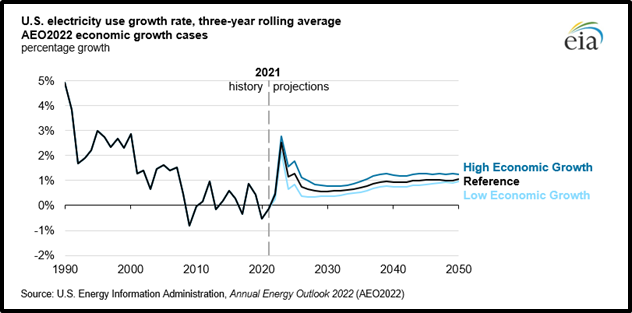
Given the complexity of the siting and permitting process, even a successful transmission project may take more than a decade to complete. With this in mind, Governors may want to consider the changes projected to take place on the grid over the long term. In 2011, coal accounted for more than 42% of all electricity generated in the United States. A decade later coal makes up only approximately 21.6% of U.S. electricity. Over the same period, natural gas usage grew from 24.7% to 37.8%, and wind grew from less than 3% to more than 9% of U.S. electricity generation. The Energy Information Administration’s Annual Energy Outlook 2022 projects U.S. energy generation, after correcting for the disruption of the COVID-19 pandemic, will grow at a slow but steady rate of between .5%-1% annually. As Figure 2 below shows, this growth rate could be variable depending on the broader growth in the economy.
However, even within the “High Economic Growth” and “Low Economic Growth” models, the rate of growth is projected to gradually increase over the next three decades. This contrasts with much more volatile historic electricity usage. While this growth rate is slow, the second chart shows an expected increase in the diversity of generation sources.
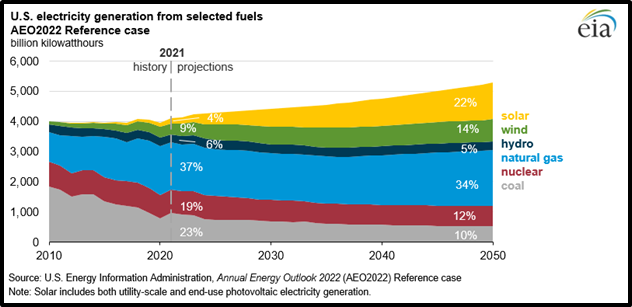
The rapid changes in generation resources over the past decade and the projected electrification and growth and diversification of future generation resources are driven by a variety of macroeconomic and policy forces, many of which are often outside of the control of individual Governors. As such, it is important to plan transmission projects with a dynamic and changing grid front of mind. Responding to a growing demand for electrification and new transmission lines, Governors have several actions and tools at their disposal to expedite the transmission siting and permitting process. The actions and tools noted above are not a complete list of potential options; each state’s regulatory scheme varies and seeking out solutions that fit your state’s needs is always advised.
While there is no silver bullet to accelerate transmission projects, Governors have both long term and short-term solutions at their disposal. By initiating and coordinating new regional compacts and multi-state agreements, Governors can streamline the siting and permitting of interstate transmission lines. Some short-term solutions Governors have at their disposal are evaluating whether a single state approach is the best fit, engaging with local communities and Tribes earlier, and taking inventory of the state’s preparedness for siting and permitting interstate transmission lines.
The siting and permitting process for transmission requires coordination from all levels of government and is often a lengthy and difficult process. Using the actions and tools noted above, Governors can be both advocates and facilitators in advancing their state’s interstate transmission siting and permitting goals.
Disclaimer
This material is based upon work supported by the Department of Energy, Office of Electricity under Award Number DE-OE0000927.
This report was prepared as an account of work sponsored by an agency of the United States Government. Neither the United States Government nor any agency thereof, nor any of their employees, makes any warranty, express or implied, or assumes any legal liability or responsibility for the accuracy, completeness, or usefulness of any information, apparatus, product, or process disclosed, or represents that its use would not infringe privately owned rights. Reference herein to any specific commercial product, process, or service by trade name, trademark, manufacturer, or otherwise does not necessarily constitute or imply its endorsement, recommendation, or favoring by the United States Government or any agency thereof. The views and opinions of authors expressed herein do not necessarily state or reflect those of the United States Government or any agency thereof.
Authors
Transmission Siting and Permitting: How Governor Leadership Can Advance Projects was written by Chris Fletcher, Dan Lauf, and Alex Hsu (former staff).
Recommended citation format: C. Fletcher, D. Lauf, A. Hsu, Transmission Siting and Permitting: How Governor Leadership Can Advance Projects. (Washington D.C.: National Governors Association Center for Best Practices, February 2023).
Acknowledgments
The authors thank the following NGA partners and organizations for reviewing drafts and providing input into this paper: American Council on Renewable Energy, American Electric Power, American Public Power Association, Edison Electric Institute, the Federal Energy Regulatory Commission, National Association of Regulatory Utility Commissioners, National Association of State Energy Offices, National Grid, the U.S. Department of Energy (DOE) Office of Policy and the U.S DOE Grid Deployment Office.
The authors extend their gratitude to NGA colleagues Evan Blankenberger, Tim Blute. The authors also thank Joyce Kim and Jeffery Dennis from the U.S. Department of Energy, Grid Deployment Office for their support and guidance.

